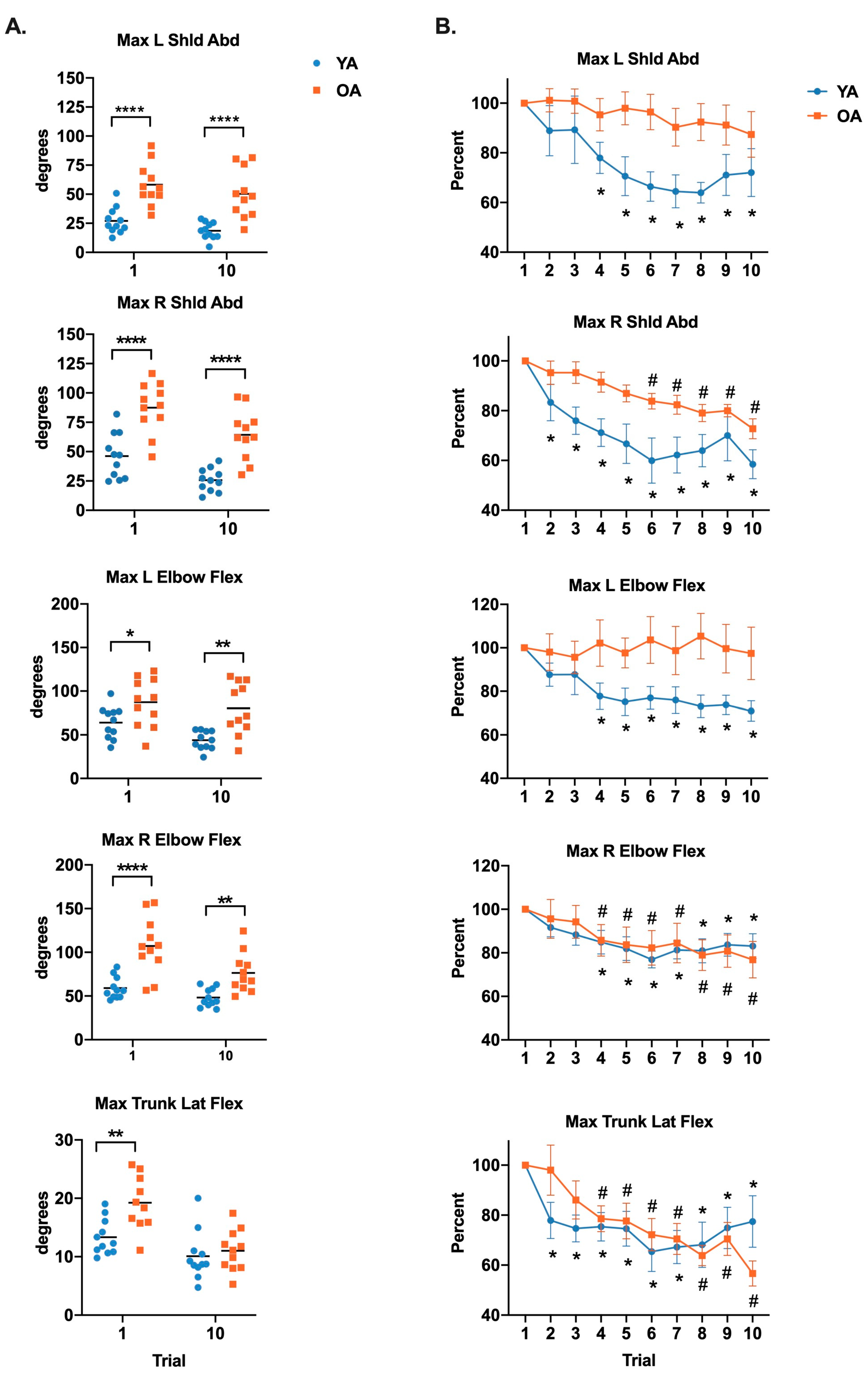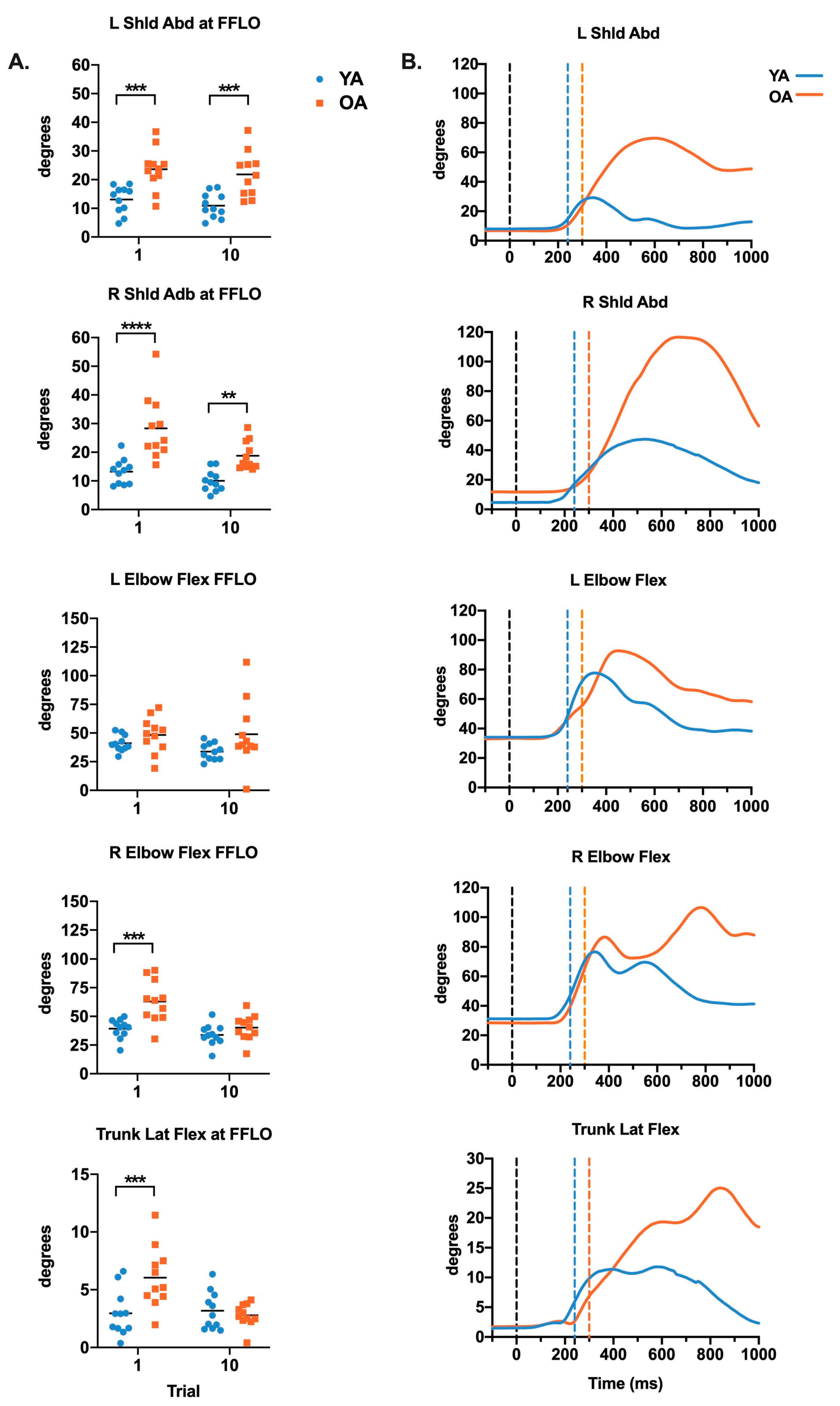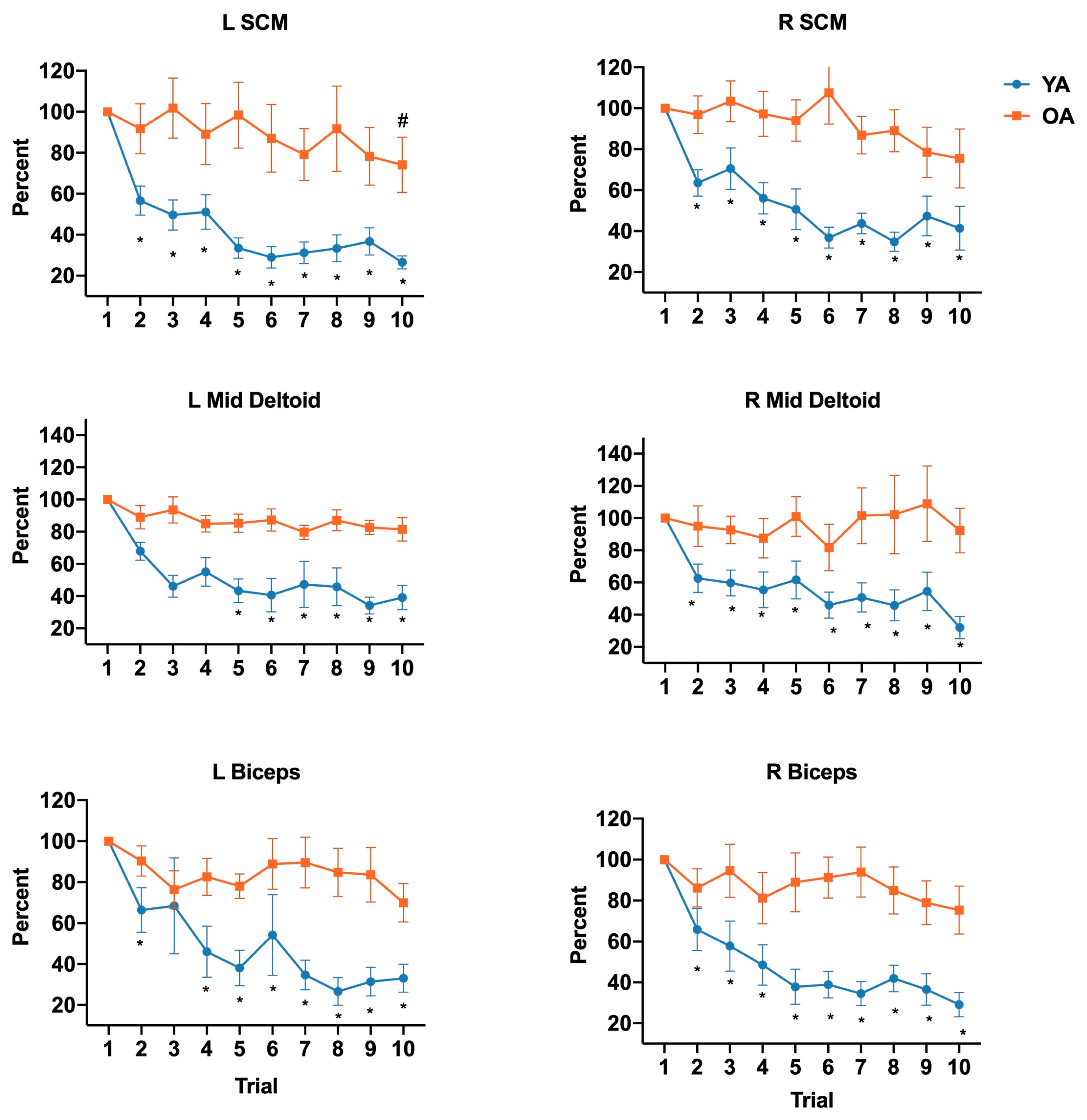Age-Related Differences in Arm and Trunk Responses to First and Repeated Exposure to Laterally Induced Imbalances
Abstract
1. Introduction
2. Materials and Methods
2.1. Participants
2.2. Protocol
2.3. Data Collection
2.4. Statistical Analysis
3. Results
3.1. First and Last Trial Age-Related Differences
3.2. Habituation
3.3. Step Types
3.4. Harness Assistance and Balance Confidence
4. Discussion
5. Conclusions
Author Contributions
Funding
Acknowledgments
Conflicts of Interest
References
- Dietz, V.; Fouad, K.; Bastiaanse, C.M. Neuronal coordination of arm and leg movements during human locomotion. Eur. J. Neurosci. 2001, 14, 1906–1914. [Google Scholar] [CrossRef]
- Misiaszek, J.E. Early activation of arm and leg muscles following pulls to the waist during walking. Exp. Brain Res. 2003, 151, 318–329. [Google Scholar] [CrossRef]
- Misiaszek, J.E.; Krauss, E.M. Restricting arm use enhances compensatory reactions of leg muscles during walking. Exp. Brain Res. 2004, 161, 474–485. [Google Scholar] [CrossRef]
- Marigold, D.S.; Misiaszek, J.E. Whole-Body Responses: Neural Control and Implications for Rehabilitation and Fall Prevention. Neuroscientist 2008, 15, 36–46. [Google Scholar] [CrossRef]
- Pijnappels, M.; Kingma, I.; Wezenberg, D.; Reurink, G.; Van Dieën, J.H.; Reurink, G. Armed against falls: The contribution of arm movements to balance recovery after tripping. Exp. Brain Res. 2009, 201, 689–699. [Google Scholar] [CrossRef]
- Grin, L.; Frank, J.; Allum, J.H.J. The effect of voluntary arm abduction on balance recovery following multidirectional stance perturbations. Exp. Brain Res. 2006, 178, 62–78. [Google Scholar] [CrossRef][Green Version]
- Holliday, P.; Fernie, G.; Gryfe, C.; Griggs, G. Video Recording of Spontaneous Falls of the Elderly. In Slips, Stumbles, and Falls: Pedestrian Footwear and Surfaces; ASTM International: West Conshohocken, PA, USA, 2009; Volume 7. [Google Scholar] [CrossRef]
- Yang, Y.; Mackey, D.C.; Liu-Ambrose, T.; Leung, P.-M.; Feldman, F.; Robinovitch, S.N. Clinical Risk Factors for Head Impact During Falls in Older Adults. J. Head Trauma Rehabil. 2017, 32, 168–177. [Google Scholar] [CrossRef]
- Schonnop, R.; Yang, Y.; Feldman, F.; Robinson, E.; Loughin, M.; Robinovitch, S.N. Prevalence of and factors associated with head impact during falls in older adults in long-term care. Can. Med Assoc. J. 2013, 185, E803–E810. [Google Scholar] [CrossRef]
- Maki, B.E.; Edmondstone, M.A.; McIlroy, W.E.; Hagerman, F.C.; Walsh, S.J.; Staron, R.S.; Hikida, R.S.; Gilders, R.M.; Murray, T.F.; Toma, K.; et al. Age-Related Differences in Laterally Directed Compensatory Stepping Behavior. J. Gerontol. Ser. A: Boil. Sci. Med Sci. 2000, 55, M270–M277. [Google Scholar] [CrossRef]
- Tang, P.-F.; Woollacott, M.H. Inefficient postural responses to unexpected slips during walking in older adults. J. Gerontol. Ser. A Boil. Sci. Med Sci. 1998, 53, M471–M480. [Google Scholar] [CrossRef]
- Allum, J.H.J.; Carpenter, M.G.; Honegger, F.; Adkin, A.L.; Bloem, B.R. Age-dependent variations in the directional sensitivity of balance corrections and compensatory arm movements in man. J. Physiol. 2002, 542, 643–663. [Google Scholar] [CrossRef]
- Roos, P.E.; McGuigan, M.P.; Kerwin, D.G.; Trewartha, G. The role of arm movement in early trip recovery in younger and older adults. Gait Posture 2008, 27, 352–356. [Google Scholar] [CrossRef]
- Nijhuis, L.B.O.; Allum, J.H.J.; Valls-Solé, J.; Overeem, S.; Bloem, B.R. First Trial Postural Reactions to Unexpected Balance Disturbances: A Comparison with the Acoustic Startle Reaction. J. Neurophysiol. 2010, 104, 2704–2712. [Google Scholar] [CrossRef][Green Version]
- Blouin, J.-S.; Siegmund, G.P.; Inglis, J.T. Interaction between acoustic startle and habituated neck postural responses in seated subjects. J. Appl. Physiol. 2007, 102, 1574–1586. [Google Scholar] [CrossRef]
- Davis, M.; Falls, W.A.; Campeau, S.; Kim, M. Fear-potentiated startle: A neural and pharmacological analysis. Behav. Brain Res. 1993, 58, 175–198. [Google Scholar] [CrossRef]
- Sanders, O.; Hsiao, H.Y.; Savin, D.N.; Creath, R.A.; Rogers, M. Aging changes in protective balance and startle responses to sudden drop perturbations. J. Neurophysiol. 2019, 122, 39–50. [Google Scholar] [CrossRef]
- Shelkey, M.; Wallace, M. Katz Index of Independence in Activities of Daily Living (ADL). Directories (Cincinnati Ohio) 2000, 8, 72–73. [Google Scholar]
- Cheng, K.C.; McKay, S.M.; King, E.C.; Maki, B.E. Reaching to recover balance in unpredictable circumstances: Is online visual control of the reach-to-grasp reaction necessary or sufficient? Exp. Brain Res. 2012, 218, 589–599. [Google Scholar] [CrossRef][Green Version]
- Weaver, T.B.; Tokuno, C.D. The influence of handrail predictability on compensatory arm reactions in response to a loss of balance. Gait Posture 2013, 38, 293–298. [Google Scholar] [CrossRef]
- Mille, M.-L.; Johnson-Hilliard, M.; Martinez, K.M.; Zhang, Y.; Edwards, B.J.; Rogers, M.W. One Step, Two Steps, Three Steps More … Directional Vulnerability to Falls in Community-Dwelling Older People. J. Gerontol. Ser. A Boil. Sci. Med Sci. 2013, 68, 1540–1548. [Google Scholar] [CrossRef] [PubMed]
- Hilliard, M.J.; Martinez, K.M.; Janssen, I.; Edwards, B.J.; Mille, M.-L.; Zhang, Y.; Rogers, M.W. Lateral Balance Factors Predict Future Falls in Community-Living Older Adults. Arch. Phys. Med. Rehabil. 2008, 89, 1708–1713. [Google Scholar] [CrossRef]
- Maki, B.E.; McIlroy, W.E. Control of rapid limb movements for balance recovery: Age-related changes and implications for fall prevention. Age Ageing 2006, 35, ii12–ii18. [Google Scholar] [CrossRef]
- Yang, F.; Pai, Y.-C. Automatic recognition of falls in gait-slip training: Harness load cell based criteria. J. Biomech. 2011, 44, 2243–2249. [Google Scholar] [CrossRef]
- Keshner, E.; Allum, J.; Pfaltz, C. Postural coactivation and adaptation in the sway stabilizing responses of normals and patients with bilateral vestibular deficit. Exp. Brain Res. 1987, 69, 77–92. [Google Scholar] [CrossRef] [PubMed]
- Nijhuis, L.B.O.; Allum, J.H.J.; Borm, G.F.; Honegger, F.; Overeem, S.; Bloem, B.R. Directional Sensitivity of “First Trial” Reactions in Human Balance Control. J. Neurophysiol. 2009, 101, 2802–2814. [Google Scholar] [CrossRef] [PubMed]
- Merriaux, P.; Dupuis, Y.; Boutteau, R.; Vasseur, P.; Savatier, X. A Study of Vicon System Positioning Performance. Sensors 2017, 17, 1591. [Google Scholar] [CrossRef] [PubMed]
- Powell, L.E.; Myers, A.M. The Activities-specific Balance Confidence (ABC) Scale. J. Gerontol. Ser. A Boil. Sci. Med Sci. 1995, M28–M34. [Google Scholar] [CrossRef]
- Ganesan, M.; Kanekar, N.; Aruin, A.S. Direction-specific impairments of limits of stability in individuals with multiple sclerosis. Ann. Phys. Rehabil. Med. 2015, 58, 145–150. [Google Scholar] [CrossRef]
- Dreissen, Y.E.; Bakker, M.J.; Koelman, J.H.; Tijssen, M.A. Exaggerated startle reactions. Clin. Neurophysiol. 2012, 123, 34–44. [Google Scholar] [CrossRef]
- Mille, M.-L.; Johnson, M.E.; Martinez, K.M.; Rogers, M.W. Age-dependent differences in lateral balance recovery through protective stepping. Clin. Biomech. 2005, 20, 607–616. [Google Scholar] [CrossRef]
- Maki, B.E. Gait Changes in Older Adults: Predictors of Falls or Indicators of Fear? J. Am. Geriatr. Soc. 1997, 45, 313–320. [Google Scholar] [CrossRef] [PubMed]
- Menz, H.B.; Lord, S.R.; Fitzpatrick, R.C. A structural equation model relating impaired sensorimotor function, fear of falling and gait patterns in older people. Gait Posture 2007, 25, 243–249. [Google Scholar] [CrossRef] [PubMed]
- Carpenter, M.G.; Frank, J.S.; Silcher, C.P. Surface height effects on postural control: A hypothesis for a stiffness strategy for stance. J. Vestib. Res. 1999, 9, 277–286. [Google Scholar] [PubMed]
- Carpenter, M.G.; Frank, J.S.; Adkin, A.L.; Paton, A.; Allum, J. Influence of Postural Anxiety on Postural Reactions to Multi-Directional Surface Rotations. J. Neurophysiol. 2004, 92, 3255–3265. [Google Scholar] [CrossRef]
- Davis, R.C.; Landis, C.; Hunt, W.A. The Startle Pattern. Am. J. Psychol. 1941, 54, 148. [Google Scholar] [CrossRef]
- Nieuwenhuijzen, P.; Schillings, A.M.; Van Galen, G.P.; Duysens, J. Modulation of the startle response during human gait. J. Neurophysiol. 2000, 84, 65–74. [Google Scholar] [CrossRef]
- Brown, P.; Day, B.L.; Rothwell, J.C.; Thompson, P.D.; Marsden, C.D. The effect of posture on the normal and pathological auditory startle reflex. J. Neurol. Neurosurg. Psychiatry 1991, 54, 892–897. [Google Scholar] [CrossRef]
- Westlake, K.P.; Wu, Y.; Culham, E.G. Velocity discrimination: Reliability and construct validity in older adults. Hum. Mov. Sci. 2007, 26, 443–456. [Google Scholar] [CrossRef]
- Westlake, K.P.; Culham, E.G. Sensory-Specific Balance Training in Older Adults: Effect on Proprioceptive Reintegration and Cognitive Demands. Phys. Ther. 2007, 87, 1274–1283. [Google Scholar] [CrossRef]
- Allum, J.H.J.; Nijhuis, L.B.O.; Carpenter, M.G. Differences in coding provided by proprioceptive and vestibular sensory signals may contribute to lateral instability in vestibular loss subjects. Exp. Brain Res. 2007, 184, 391–410. [Google Scholar] [CrossRef]
- Thelen, D.; Wojcik, L.A.; Schultz, A.B.; Ashton-Miller, J.A.; Alexander, N.B. Age Differences in Using a Rapid Step to Regain Balance during a Forward Fall. J. Gerontol. Ser. A Boil. Sci. Med Sci. 1997, 52, 8–13. [Google Scholar] [CrossRef] [PubMed]
- Rogers, M.W.; Mille, M.-L. Lateral Stability and Falls in Older People. Exerc. Sport Sci. Rev. 2003, 31, 182–187. [Google Scholar] [CrossRef] [PubMed]
- Lattimer, L.J.; Lanovaz, J.L.; Farthing, J.P.; Madill, S.J.; Kim, S.; Arnold, C. Upper limb and trunk muscle activation during an unexpected descent on the outstretched hands in young and older women. J. Electromyogr. Kinesiol. 2016, 30, 231–237. [Google Scholar] [CrossRef] [PubMed]
- Maki, B.E.; Holliday, P.J.; Topper, A.K. Fear of Falling and Postural Performance in the Elderly. J. Gerontol. 1991, 46, M123–M131. [Google Scholar] [CrossRef] [PubMed]
- Allum, J.H.J.; Tang, K.-S.; Carpenter, M.; Nijhuis, L.O.; Bloem, B. Review of first trial responses in balance control: Influence of vestibular loss and Parkinson’s disease. Hum. Mov. Sci. 2011, 30, 279–295. [Google Scholar] [CrossRef]
- Inacio, M.; Creath, R.; Rogers, M.W. Effects of aging on hip abductor-adductor neuromuscular and mechanical performance during the weight transfer phase of lateral protective stepping. J. Biomech. 2019, 82, 244–250. [Google Scholar] [CrossRef]
- Nanhoe-Mahabier, W.; Allum, J.H.J.; Overeem, S.; Borm, G.; Nijhuis, L.O.; Bloem, B.R. First trial reactions and habituation rates over successive balance perturbations in Parkinson’s disease. Neuroscientist 2012, 217, 123–129. [Google Scholar] [CrossRef]
- Siegmund, G.P.; Blouin, J.-S.; Inglis, J.T. Does Startle Explain the Exaggerated First Response to a Transient Perturbation? Exerc. Sport Sci. Rev. 2008, 36, 76–82. [Google Scholar] [CrossRef]




| Muscle | Older Adults | Younger Adults | p-Value | ||
|---|---|---|---|---|---|
| Trial 1 | Trial 1 0 | Trial 1 | Trial 10 | ||
| Left SCM | 140.9 ± 12.89 | 122.8 ± 9.00 | 127.8 ± 15.18 | 128.4 ± 12.69 | 0.79 |
| Right SCM | 144.4 ± 14.43 | 141.9 ± 8.57 | 124.3 ± 11.53 | 147.8 ± 12.80 | 0.61 |
| Left Mid Deltoid | 139.6 ± 13.06 | 131.0 ± 6.74 | 125.8 ± 10.58 | 132.5 ± 10.61 | 0.59 |
| Right Mid Deltoid | 142.7 ± 12.37 | 125.3 ± 8.37 | 120.6 ± 10.94 | 125.5 ± 10.37 | 0.36 |
| Left Biceps | 149.6 ± 12.61 | 129.3 ± 9.42 | 126.9 ± 11.12 | 140.9 ± 13.08 | 0.68 |
| Right Biceps | 147.7 ± 13.89 | 144.7 ± 8.43 | 128.6 ± 10.95 | 140.0 ± 11.00 | 0.36 |
| FFLO Onset Latency | 263.6 ± 19.55 | 226.4 ± 9.17 | 216.4 ± 8.45 | 214.5 ± 9.28 | 0.03 * |
| Muscle | Older Adults | Younger Adults | p-Value | ||
|---|---|---|---|---|---|
| Trial 1 | Trial 10 | Trial 1 | Trial 10 | ||
| Left SCM | 272.9 ± 21.27 | 167.6 ± 1.16 | 127.8 ± 1.10 | 135.6 ± 1.11 | 0.01 * |
| Right SCM | 161.1 ± 1.24 | 129.9 ± 1.06 | 148.2 ± 1.15 | 122.0 ± 3.59 | 0.66 |
| Left Mid Deltoid | 199.5 ± 8.31 | 126.0 ± 2.05 | 122.9 ± 1.06 | 117.0 ± 1.11 | 0.03 * |
| Right Mid Deltoid | 307.3 ± 1.25 | 137.9 ± 1.19 | 128.3 ± 1.06 | 137.9 ± 1.13 | 0.04 † |
| Left Biceps | 221.9 ± 1.22 | 151.9 ± 1.07 | 124.8 ± 1.08 | 136.6 ± 1.13 | 0.02 * |
| Right Biceps | 319.2 ± 1.25 | 124.8 ± 1.08 | 122.7 ± 1.05 | 147.9 ± 1.19 | 0.01 * |
© 2020 by the authors. Licensee MDPI, Basel, Switzerland. This article is an open access article distributed under the terms and conditions of the Creative Commons Attribution (CC BY) license (http://creativecommons.org/licenses/by/4.0/).
Share and Cite
Akinlosotu, R.Y.; Alissa, N.; Sorkin, J.D.; Wittenberg, G.F.; Westlake, K.P. Age-Related Differences in Arm and Trunk Responses to First and Repeated Exposure to Laterally Induced Imbalances. Brain Sci. 2020, 10, 574. https://doi.org/10.3390/brainsci10090574
Akinlosotu RY, Alissa N, Sorkin JD, Wittenberg GF, Westlake KP. Age-Related Differences in Arm and Trunk Responses to First and Repeated Exposure to Laterally Induced Imbalances. Brain Sciences. 2020; 10(9):574. https://doi.org/10.3390/brainsci10090574
Chicago/Turabian StyleAkinlosotu, Ruth Y., Nesreen Alissa, John D. Sorkin, George F. Wittenberg, and Kelly P. Westlake. 2020. "Age-Related Differences in Arm and Trunk Responses to First and Repeated Exposure to Laterally Induced Imbalances" Brain Sciences 10, no. 9: 574. https://doi.org/10.3390/brainsci10090574
APA StyleAkinlosotu, R. Y., Alissa, N., Sorkin, J. D., Wittenberg, G. F., & Westlake, K. P. (2020). Age-Related Differences in Arm and Trunk Responses to First and Repeated Exposure to Laterally Induced Imbalances. Brain Sciences, 10(9), 574. https://doi.org/10.3390/brainsci10090574






